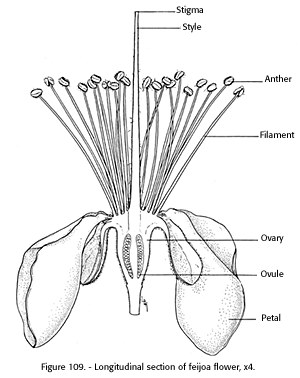FEIJOA
Feijoa sellowiana Berg., family MyrtaceaeFeijoa is a subtropical plant native to South America but grown to a limited extent in Florida and California with occasional plantings of 1 to 2 acres (Schroeder 1949). Feijoa prefers a mild temperature with 30 to 40 inches of rain a year (Bailey 1952). Its product is the delectable fruit that is eaten fresh, out of hand, stewed, or processed into jam or jelly. Clark (1926) reported that 9-year-old plants were producing fruit at the rate of 10,000 lb/acre and had not reached maximum production.
Plant:
The evergreen plant reaches 15 to 18 feet with various shapes. The fruit is round, oval or oblong, 1 to 3 inches long, and dull green with a whitish bloom. The thin skin covers a whitish granular flesh about 1/4- inch thick around a translucent jellylike pulp in which 20 to 30 minute seeds are embedded. The flavor suggests pineapple or strawberry, and the aroma is delightful. The fruit is sometimes called pineapple guava.
The plants are generally spaced 15 to 18 feet apart. Irrigation is necessary for best production in California (Popenoe 1920).
Inflorescence:
The handsome flower, as described by Popenoe (1920), is 11/2 inches across with edible fleshy cupped petals that are white on the outside and purplish within. The long, stiff stamens form a conspicuous crimson tuft in the center, with the one stigma extending above the stamens (fig. 109).
[gfx] FIGURE 109. - Longitudinal section of feijoa flower, x 4.

Pollination Requirements:
Popenoe (1912, 1920) stated that some plants are self-sterile, whereas others are self-fertile, but even the self-fertile ones were not self-pollinating. Ryerson (1914) found in a preliminary test that six different seedling plants were self-sterile. Clark (1926) found one cultivar that apparently did not need cross-pollination, but transfer of pollen within the flower was necessary. Ryerson (1933) again stated that the feijoa tends toward self-sterility.
Pollinators:
Popenoe (1920) and later Ryerson (1933) stated that birds feeding upon the edible petals in their native habitat became dusted with pollen from the tuft of anthers then when they visited another flower they affected cross-pollination. Schroeder (1953) believed that transfer of pollen between plants either by insects or man was required.
Clark (1926) reported that honey bees were the only insects that visited the flowers, and they gathered no nectar, only pollen. Plants screened to keep bees off set only 9 percent of the flowers while those visited by bees set 40 percent of their flowers.
Schroeder (1947) conducted a thorough test on five cultivars under cheesecloth in Los Angeles during 1945 and 1946. He found that open pollinated flowers set about 16 times as well as comparable flowers under cage. He then and later (1953) concluded that the feijoa is pollinated by insects, primarily by bees, and that most cultivars "show markedly improved fruit-set when cross-pollinated. "
Pollination Recommendations and Practices:
The evidence indicates that the plants must be pollinated by bees unless the proper species of birds are available. No recommendations on methods of using bees have been made. Should the acreage increase the proper usage of bees would doubtless be necessary.
LITERATURE CITED:
BAILEY F. L.
1952. CULTURE OF FEIJOA TREES. New Zeal. Jour. Agr. 84: 291 - 293, 295 - 296.CLARK, O. I.
1926. POLLINATION OF FEIJOAS. Calif. Avocado Assoc. Ann. Rpt. 1925-26: 94-95.POPENOE, F. W.
1912. FEIJOA SELLOWIANA: ITS HISTORY, CULTURE AND VARIETIES. Pomona Col. Jour. of Bot. 2(1): 217 - 242.POPENOE, W.
1920. MANUAL OF TROPICAL AND SUBTROPICAL FRUITS. 474 pp. The Macmillan Co., New York.RYERSON, K. A.
1914. SUMMARY OF PRELIMINARY FEIJOA POLLINATION EXPERIMENTS. Calif. Univ. Jour. Agr. 2: 51-53.______ 1933. THE FEIJOA. Natl. Hort. Mag. 12: 241 - 245.
SCHROEDER, C. A.
1947. POLLINATION REQUIREMENTS OF THE FEIJOA. Amer. Soc. Hort. Sci. Proc. 49: 161 - 162._______ 1949. THE FEIJOA IN CALIFORNIA. Fruit Varieties and Hort. Digest 4: 99 - 101.
______ 1953. THE POLLINATION OF SOME SUBTROPICAL FRUIT TREES. Lasca Leaves 3: 39-41.
